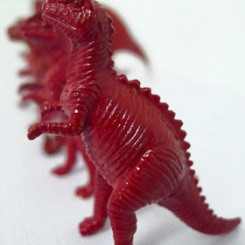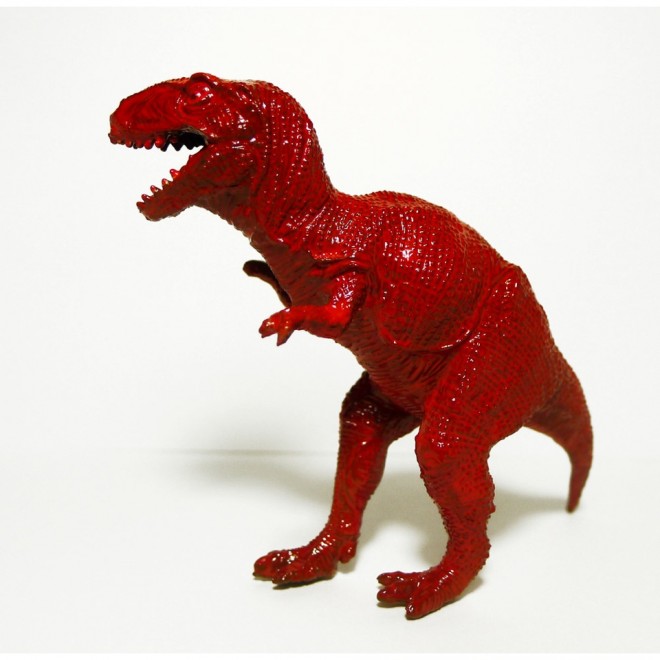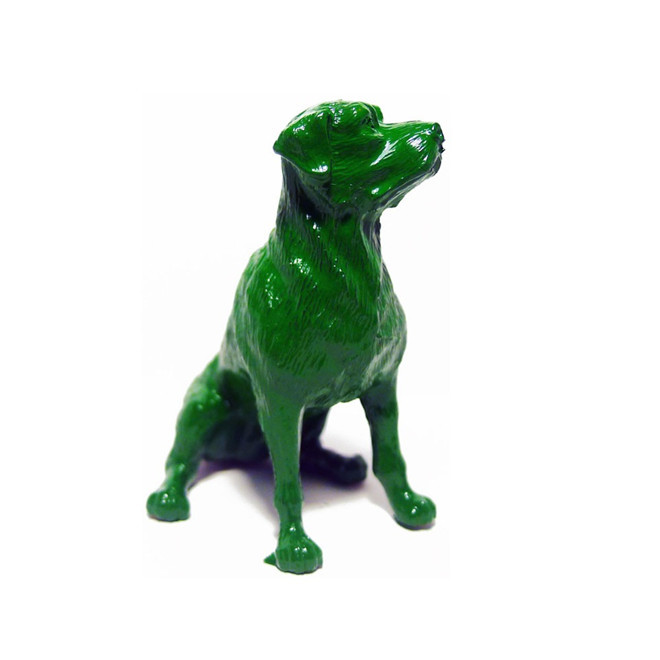Ever wanted to own a Zhou Chunya or an Ai Weiwei? Well, now collector status is close within your reach—all for less than 50 RMB. We all knew it was a matter of time before someone started selling art on Taobao and now artist and former curator Weng Zhijuan brings us access to the moguls of the art world with miniature versions of Ai Weiwei’s “Sunflower Seeds,” Zhan Wang’s “Artificial Rocks,” Sui Jianguo’s “Made in China,” and Zhou Chunya’s “Green Dog” series with a starting price of 2 RMB.
Unsurprisingly, 2 Yuan Gallery quickly incited debates online, especially on social networks like Weibo and Wechat. Some stakeholders including the students of Zhan Wang and the curator of White Box Art Museum in Beijing accused Weng of copyright infringement, while some netizens saw Weng as a hero who brave enough to ridicule pompous artists—bringing art down to the grassroots. Weng fashions the gallery as an artwork itself which borrows contemporary art symbols, creating a satire which questions the astronomical prices of these works. Randian sat down to talk with Weng about the project, its inception and reception in the art world.
Randian: You have previous experience in curating, art reporting, the art market and art management. Have these experiences in the commercial art world influenced you in the creation of 2 Yuan Gallery?
Weng Zhijuan: I have been in art circles for ten years, since entering Long March Space as a visual supervisor in 2003. Experiences like curating and writing reviews have given me a clear idea about the conditions and rules in this circle, as well as the social network and resources. These factors set me apart from normal artists.
Though there were lots of reasons to stay in my former job, but I have always wanted to be an artist. 2 Yuan Gallery is my debut work. The precursor to 2 Yuan Galley was a week-long exhibition in a 4-square-meter art space on Anshun Road called the Bazaar Compatible Program. The space is located on the way to a vegetable market, where many shoppers go and where cheap knockoff goods are sold. I wanted to do a show which would meld into this environment, rather than trying to be high-end. Regular people need art too. So I stuck many butterflies on one side of the walls, which was an imitation of Damien Hirst’s work. People didn’t know Damien Hirst, but they know about butterflies. Some of them told me that this is the first piece of work in the space that they were able to understand.
Randian: Can you tell us about your ideas behind pricing?
WZJ: I didn’t mean to ask pointed questions to any individual artist. I mainly wanted to draw people’s attention to the high prices of artworks. Some famous artists now either relentlessly copy themselves or overuse their own symbols, creating a new work by slightly adjusting a former one. Then these works go directly to auction, without going through galleries. This has nothing to do with art any more—it’s all about the market.
I also want to take this chance to have a good laugh at these high-priced artists. Why do you think so many painters in China have started to make sculptures, for example Zhang Xiaogang, who made his own paintings into sculptures in 2012? Some even do prints. The two-dimensional language and three-dimensional languages are totally different. Thus, it is questionable to make paintings into sculptures and sell them afterwards.
Many Chinese artists who are serious about their art are in poor financial situations. Some of them become kept men while others perform various kinds of drudgery in order to feed themselves. An artist friend of mine who has acrophobia once climbed high up to spray paint for some money. These people see art as their religion. Otherwise, they would have given it up.
Randian: Did you make all the artworks by yourself?
WZJ: I made them all except for the “Sunflower Seeds,” which were provided by a supplier.
Randian: Why did you choose Ai Weiwei, Zhan Wang, Sui Jianguo and Zhou Chunya? Was it because they represent some profitable commercial artists?
WZJ: Actually, these choices are more of a coincidence. My primary concern has been feasibility — not the artists. The works I chose are easy to parody. Some of the inspiration comes from my online shopping experiences. I thought of parodying Sui Jianguo’s “Made in China” series when I saw some dinosaur models for sale on the net. I also thought about parodying Zhang Xiaogang’s work, but later gave this idea up because it is hard to make, and also raises the problem of copyright infringement.
Randian: Did you expect such a heated reaction on the internet?
WZJ: Not at all. It has so far surpassed my expectations. At first, I only saw 2 Yuan Gallery as an artwork, which even I felt tired and frustrated about. I think the reaction on the internet can be partly attributed to the increasing popularity of social networks such as Weibo.
A guy said on Weibo that he had finally found someone who doesn’t follow trends. Portal websites like Sina and Sohu all reported it. Groups of art collectors also responded. They deal with auctions all day, and finally here comes a person openly “deprecating” art, which I think struck a chord.
Randian: Do you intend to make a profit from selling the artworks?
WZJ: Actually, that is quite impossible; besides, earning money is not my intent. The paint alone costs several hundred RMB, which there is no way to recover—not to mention the money I spent buying dinners for the artists who lent me their studios.
Randian: Approximately how many items has the gallery sold so far? Did the number meet your expectations? Which artwork was the most popular?
WZJ: At first it was miserable, just approaching two digits by last summer. And as I didn’t promote the works as commodities, the buyers came only sporadically but were more diversified. For example the professional collector Bao Yifeng has bought three sets of artificial rocks and three hundred packages of sunflower seeds. There was also an art shop in Guangxi ordered twenty sets of dinosaurs and green dogs. By now thousands of sunflower seeds have been sold and two categories of green dogs are out of stock, which I haven’t made many. Ai Weiwei’s “Sunflower Seeds” are the most popular—he is the most famous artist.
To be honest I don’t want too many buyers—the cost in terms of time is pretty high. But as long as the buyers come, they will get what they want.
Randian: Do you personally know some of the buyers?
WZJ: Mostly not. They come from all over the country including Shanghai, Henan, Wuhan, Guangdong and Beijing. I don’t know what these people do, but it is good to keep a sense of mystery.
WZJ: The green dog and the dinosaur are sold for 50 Yuan each. Although it is still not enough to cover costs, it is acceptable for both me and the buyers. Giving out artworks for free is eye-catching, but it will only be a one-time thing. A price of 50 Yuan can convey my idea and keep me going without too great a loss.
Randian: What do you think is the relationship between the artworks in 2 Yuan Gallery and the original ones?
WZJ: I would call it parody. Some people accuse me of copying and infringing copyright, which does not make any sense. All I did was to buy a toy model and paint it—something that everyone has the right to do. Li Juchuan said on Weibo that in fact, artists themselves make artworks out of toys. You can see model dinosaurs everywhere. Also, for the Artificial Rocks series, I made them out of natural rocks that everyone can use.
Those who said I am infringing on copyright are actually the ones questioning the value of artworks. Think about it: if artists’ works can easily be copied by anyone, shouldn’t we question the value of the work?
Randian: Has anyone before you sold artworks at such low prices? Do you think what you are doing is unique?
WZJ: I am not the only one. There are several forerunners. Pianshan sold all his works for 0 Yuan in 2006. And in the 2012 Shanghai Biennale, the Pittsburgh city Pavilion held “The Lovasik Estate Sale” (by Jon Rubin), where second hand furniture was sold at low prices. Marina Abramovic has sold hugs for one dollar each to raise money for her own art museum.
Randian: Have the artists responded to your work?
WZJ: They haven’t. Among those who accused me of copyright infringement are students of Zhan Wang and the curator of White Box Art Museum who was then holding an exhibition of Sui Jianguo’s works. They are all stakeholders who do not represent the opinion of the artists. It’s too obvious to even mention the fact that I haven’t infringed on copyright. Some media sources tried to interview Sui about this, but he refused to comment.
Whether it is simply a provocative parody of the art world or a gross copyright infringement, 2 Yuan Gallery has brought a sense of populism to the elitist art world. Just like the 2 yuan “dollar stores” in the backstreets of Chinese cities stubbornly battling large chain retailers, who possess large marketing budgets. Between cheers, boos and silence, the gallery itself is something of a microcosm of the art world— its egos and pitched battles for recognition.







